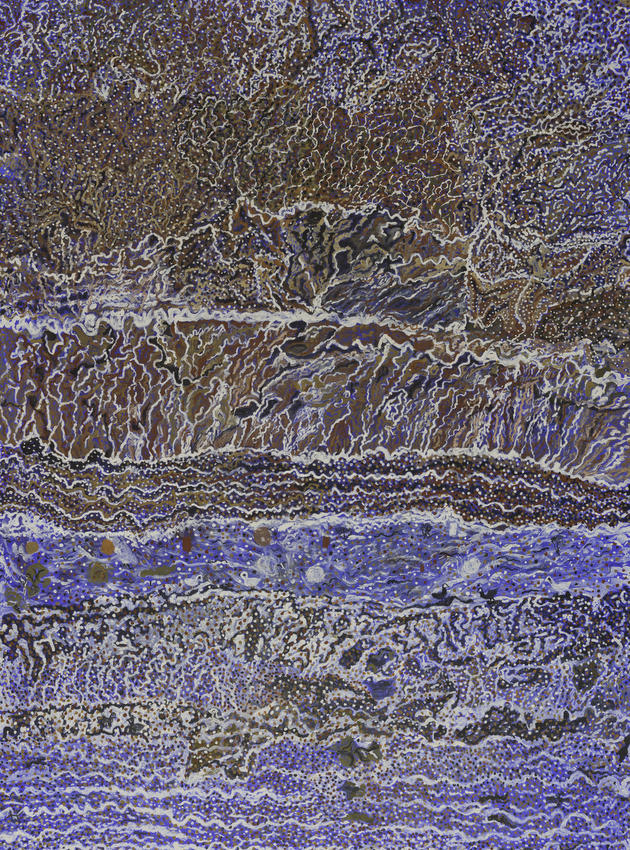We acknowledge the Traditional Owners of the land on which the Queensland Art Gallery | Gallery of Modern Art stands and recognise the creative contribution First Australians make to the art and culture of this country.

Mavis Ngallametta / Kugu-Uwanh people, Putch clan / Australia 1944–2019 / Wutan #2 2014 / Natural pigments and charcoal with acrylic binder on canvas / 272 x 200cm / Purchased 2015 with funds from Cathryn Mittelheuser, AM, through the Queensland Art Gallery | Gallery of Modern Art Foundation / Collection: Queensland Art Gallery | Gallery of Modern Art / © The Estate of Mavis Ngallametta
Mavis NGALLAMETTAWutan #2 2014
On Display: QAG, Gallery 13
Mavis Ngallametta’s Wutan #2 is a large, portrait-format landscape that charts a tract of land and water, from tiny inland streams to wild rivers and rivulets, to the coast of the Gulf of Carpentaria, where Wutan — a historically, culturally and personally significant site — sits at the mouth of the Archer River on Cape York Peninsula.
Wutan’s position at the mouth of one of the Cape’s great wild rivers ensured a story place that was a rich hunting ground for the local Wik and Kugu people. It was also the site of a radar station established by the Royal Australian Air Force in 1943, and locals have related stories of Japanese submarines entering the Archer River at this site.
Many local men joined the Australian Defence Force, working alongside their Torres Strait Islander neighbours in the Torres Strait Light Infantry Battalion, to protect the maritime borders of far north Queensland.
For Ngallametta, Wutan is a site of personal significance — during the mission days, school children would camp there. It is also the country of her adopted son Edgar, who now helps manage the area.1
Endnotes:
1 Bruce McLean, ‘Mavis Ngallametta Wutan #2 2014′, Artlines, no.3, 2015, p.36.
Mavis Ngallametta was born in 1944 into the Marbunt family of the Kugu people on their traditional country, near the Kendall River in west Cape York Peninsula. An elder of the Putch clan and a cultural leader of the Wik and Kugu people of Aurukun, Mavis is remembered for her rich legacy to her community and to art and culture nationally. Mavis embarked on her journey to become a painter relatively late in life — she did not pick up a paintbrush until 2008, at the age of 64.
Mavis lived a traditional life in the bush until she was around five, when her family was moved to the Presbyterian Mission at Aurukun. She maintained connections with family members and elders despite this upheaval, and, in time, learnt to weave dilly bags and fruit bowls made from cabbage palm and pandanus. As a result, she was first recognised for her weaving using traditional materials, which later expanded to include recycled driftnets and marine debris.
In 2008, Ngallametta began making small paintings depicting important cultural sites, and from 2010, her works grew in scale. Mavis tended to depict sites of personal significance in her paintings. Recurring subjects include Ikalath, where she collected white clay; her traditional country of Kendall River; Wutan, a camping site belonging to her adopted son Edgar; and various pamp, or swamps, dotted around Aurukun.
Discussion Questions
1. Look closely at the landscape depicted in Wutan #2. What geographical and natural features can you identify?
2. Aboriginal and Torres Strait Islander people have connections to different lands and places in Australia. Identify the traditional owners and/or language group/s in the area where your school is located. Are there any landmarks or special places that have significance for the traditional owners of this land?
Classroom Activities
Using Google Maps, select an aerial image of an area you visit frequently, e.g. your school. Create a three-dimensional representation of the area using natural materials, such as bark, leaves, and seed pods. To further convey a sense of place, consider using materials collected from the location itself.